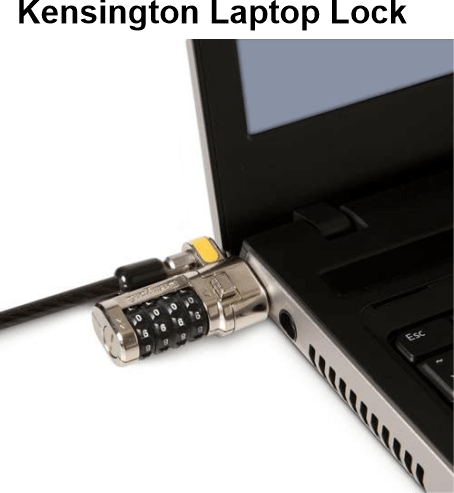What is the lockport in the laptop (Kensington lock)?The Kensington lock is also known as a K lock or K slot. It is a tiny hole that may be found on virtually all portable computers produced after 2000. Depending on the laptop type, the hole might be found on the side or in the back corner. A Kensington lock can secure a portable device on laptops with a hole for one. The lock is placed through the hole, and a cable is attached to a safe area (such as a table leg) to prevent someone from taking the laptop while you're away. 
What is the use of a lockport in a laptop?Using Kensington Locks and other security tools, you can stop computer theft. You've probably heard about Kensington locks, but you might not know what they are or have never seen one. An exclusive type of lock called a Kensington lock is designed specifically to protect pricey electronic equipment. Desktop computers can also be secured with Kensington locks, computers and monitors, even though they are normally used to secure relatively small mobile equipment, such as notebook computers and projectors. Anything that can be quickly picked up and taken should be secured with a Kensington lock. Although even this kind of crime is theoretically possible, it would obviously be impossible for someone to casually make off with a huge printer or desktop computer tower. The Kensington lock slot is located on most computer equipment. The slot is designed to provide strength by passing through both the inner metal panel and the plastic chassis's outer shell. It is a tiny rectangular hole that is generally found on the rear of equipment. A Kensington lock's business end has a T-shaped protrusion that fits through the lock slot, is twisted 90 degrees, and is then secured into place so that it cannot be withdrawn without harming the equipment. The equipment is then fastened to an immovable object, such as a pipe or a piece of furniture, with the help of a cable that is hooked to the lock. Even Kensington locks have limitations. Depending on their thickness, anyone with bolt cutters, heavy-duty wire cutters, or an axe might easily defeat the lock and cable. Additionally, a hammer may presumably be used to crush the lock right off the apparatus. However, the damage brought on by these mega-snips and hits would make it clear that the object was stolen, making selling it more challenging. Most equipment is taken from locations where it can be swiftly and readily picked up and hidden. Simply put, a Kensington lock discourages theft by making potential burglars second-guess their plans. Any person who is spotted with a pair of bolt cutters or other tools of the trade in a location where computers and electronics are utilized is likely to draw a lot of attention. There is no reason you cannot use a Kensington lock at home, business meetings, hotels, conferences, or any other location. Kensington locks are widely used in libraries, dorms, colleges, enterprises, and government offices. B&H offers a huge selection of Kensington locks. Most of them are quite generic, but some of them have specific uses in mind, like the MicroSaver Keyed Projector Lock, which is made to keep conference room projectors safe. Even security cables are produced by Sharp for particular projector models. Most Kensington locks employ keys to ensure that only those who possess the keys can unlock the apparatus. However, other Kensington locks use combination locks rather than keys, allowing you to share the combination with any dependable person. If someone with the combination turns out to be unreliable, the combination can always be changed. The Kensington ClickSafe Twin Keyed Laptop Lock can lock two devices simultaneously, unlike most locks that can only secure one piece of equipment. No matter that name frequently refers to the maker, any lock that resembles a Kensington Lock. Targus, InFocus, Peerless, and Belkin offer similar products. Also, locks can be applied to equipment without a Kensington slot. In showrooms, they are frequently employed to stop demo equipment from escaping on its own. The Belkin Bulldog Security Kit features steel plates that attach to equipment using strong glue. At the same time, the Kensington Desktop and Peripherals Locking Kit includes an anchor plate that clings to equipment using industrial-strength adhesive tape. Either of those solutions may damage the finish of your equipment if you attempt to remove the plates. The plates should ideally be attached out of sight if at all possible. Things can occasionally go missing even though they weren't stolen. Attaching Loc8tor Homing Tags to objects like key chains, remote controls, cell phones, cameras, and other items you frequently misplace is possible. These tags weigh less than 5 grams. You can use a credit card-sized device to get auditory and visual cues to lead you up to 400 feet away from any hidden object. Just be careful not to lose the actual phone! If you tend to lose everything, you might want to secure the handset with an anchor plate and security cord. A Kensington lock is an excellent place to start if computer theft is even the slightest bit of a concern for you. It is available for less than $30. Examine the many various security options that are offered after determining whether or not your equipment has a Kensington lock slot. You can have confidence in any of them.
Next TopicWhat is Punch Card System??
|
 For Videos Join Our Youtube Channel: Join Now
For Videos Join Our Youtube Channel: Join Now
Feedback
- Send your Feedback to [email protected]
Help Others, Please Share










